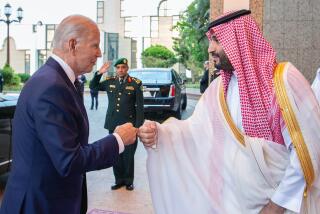Talks Held on ‘Pre-Positioning’ Arms in Saudi Arabia : Persian Gulf: Top U.S. general in region says two nations have two months to wrap up negotiations.
- Share via
DHAHRAN, Saudi Arabia — The commanding general of U.S. forces in Saudi Arabia and Kuwait said Sunday that U.S. and Saudi leaders have two months to wrap up negotiations about storage of American munitions and heavy armored equipment on Saudi Arabian territory in readiness for any future conflicts in the Persian Gulf region.
Pentagon requests to store on Saudi soil enough ammunition, equipment and other hardware for an armored division have met with opposition from senior Saudi leaders. Some of them fear establishment of a permanent American military facility in their country, home of the Muslim holy cities of Mecca and Medina.
In an interview here, Lt. Gen. Gus Pagonis confirmed that “pre-positioning” of tanks, trucks and supplies in air-conditioned bunkers inside Saudi Arabia is still the subject of negotiations between U.S. and Saudi officials.
“I have a couple of months before someone has to make a real hard decision,” said Pagonis, an Army logistics specialist who supervised the massive movement of 540,000 American troops and their equipment into Saudi Arabia during the Persian Gulf crisis.
As senior officer in charge of Operation Desert Farewell, successor to operations Desert Shield and Desert Storm, Pagonis is in command of the about 40,000 Army, Navy, Air Force and Marine personnel still in the region.
The Saudi ports of Dammam and Jubayl are crowded with dozens of ships loading military equipment for return to the United States and Europe. However, Pagonis said the operation is months from being complete, leaving open the possibility of retaining some of the materiel for storage here.
“I still have so much to move. I have 250,000 tons of ammunition--that’s 17,000 truckloads--to take to the port,” Pagonis said. “In a few months, someone is going to have to say slow down or send everything home. But right now, the decision makers have the leeway they need to be able to negotiate.”
Pentagon strategists favor storing a heavy armored division’s worth of supplies and materiel under climate-controlled conditions in Saudi Arabia. In the event of another conflict in the region, they argue, troops could be flown quickly into Saudi Arabia and “married” with the stored equipment for rapid deployment.
A Western diplomat in Riyadh, the Saudi capital, said negotiations for pre-positioning have broken down into issues of “how much equipment should be stored, where it should be housed, who is going to pay for it and who will have access to it.”
As in Europe, where pre-positioning of equipment has existed under North Atlantic Treaty Organization supervision for decades, access to the stored weaponry is probably the thorniest issue.
U.S. officials would want reassurance that Saudi Arabia would not use the materiel in conflicts against other regional states. Saudi Arabia wants the right to deny U.S. access for conflicts in which it does not share the U.S. position.
The Western diplomat said the climate for a pre-positioning agreement between the two countries, as well as other countries in the Gulf region, has improved as a result of the recent breakdown of the so-called Damascus Declaration. Under that agreement, members of the Gulf Cooperation Council first envisioned a regional Arab, NATO-style organization, with Syria and Egypt stationing troops in Saudi Arabia, Kuwait and other Gulf states.
But mainly because of fears of the ambitions of Syrian leader Hafez Assad, key points of the declaration collapsed last month. That development, the diplomat said, gave a green light for countries in the Gulf to make separate deals with the United States for their protection.
Although they favor Saudi Arabia as a site for pre-positioned materiel, U.S. military officials say it could also be placed in other Gulf states with no significant loss in strategic value.
More to Read
Sign up for Essential California
The most important California stories and recommendations in your inbox every morning.
You may occasionally receive promotional content from the Los Angeles Times.













